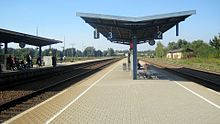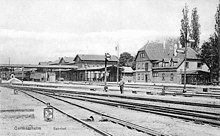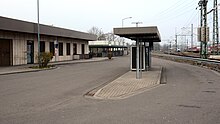Germersheim station
| Germersheim | |
|---|---|
|
Germersheim station in 2015
|
|
| Data | |
| Location in the network |
Terminus (1864–1872) Through station (1872–1876) Separation station (1876–1877) Crossing station (1877–1945) Separation station (1945–1967) Crossing station (1967–1998) Separation station (since 1998) |
| Design |
End station (1864–1876) Through station (since 1876) |
| Platform tracks | 4th |
| abbreviation | RGE |
| IBNR | 8000376 |
| Price range | 5 |
| opening | March 14, 1864 |
| Profile on Bahnhof.de | Germersheim |
| location | |
| City / municipality | Germersheim |
| country | Rhineland-Palatinate |
| Country | Germany |
| Coordinates | 49 ° 13 ′ 0 ″ N , 8 ° 22 ′ 0 ″ E |
| Railway lines | |
|
|
| Railway stations in Rhineland-Palatinate | |
The Germersheim train station is the most important train station in the middle town of Germersheim in Rhineland-Palatinate . It belongs to station category 5 and has four platform tracks . The station is in the network area of the Karlsruher Verkehrsverbund (KVV) and belongs to tariff zone 575. In the course of a transition tariff agreed in 1996, however, cards of the Verkehrsverbund Rhein-Neckar (VRN) are also recognized. The address of the station is Bahnhofstrasse 13 .
The station was opened on March 14, 1864 as the terminus of the branch line that began in Schifferstadt and previously ended in Speyer . On 16 May 1872 he was the eastern end one after Landau's leading track and in this way to the terminal station . On July 25, 1876, the line from Schifferstadt to Wörth was connected . On May 15 of the following year, the Bruhrainbahn from Bruchsal to Germersheim, which had previously ended in Rheinsheim, was tied through. The line to Landau was gradually shut down in the 1980s. Since 2006 the station has been part of the RheinNeckar S-Bahn and, since 2010, also the Karlsruhe Stadtbahn . The original station building is also a listed building .
location
Local situation
The train station is on the northern outskirts of Germersheim. A part of the track system is already on the boundary of the local community Lingenfeld . To the west of it runs parallel to the tracks, the district road 31 to Lingenfeld, to the east of it the street Am Alten Bahnhof .
Railway lines
The Schifferstadt – Wörth railway comes from a north-north-westerly direction. To the south of the train station, she circles the city in a wide arc. The Bruhrainbahn initially follows it in a southerly direction, and then crosses the state border between Baden-Württemberg and Rhineland-Palatinate in the form of the Rhine on a higher embankment . The now disused route to Landau followed the one to Schifferstadt, initially also to the north, before turning west just before the Lingenfeld train station and crossing this community through the middle of the settlement area.
history
Railway initiatives around Germersheim and opening
Originally it was planned to start operating a railway line in north-south direction from the Rheinschanze via Lauterbourg to Strasbourg within the Rhine district belonging to Bavaria , which should compete with the Mannheim – Basel line planned by Baden . However, this was postponed in favor of the Palatinate Ludwigshafen - Bexbach, which opened between 1847 and 1849 . In the period that followed, discussions took place as to whether a route along the mountains from Neustadt via Landau to Wissembourg or a route along the Rhine via Speyer , Germersheim and Wörth was more urgent and desirable. Equipping a train station for Germersheim was also the subject of debate. Since the military in particular preferred a route on the edge of the Palatinate Forest , one in the form of the Maximiliansbahn Neustadt – Wissembourg was preferred.
A branch line was then planned from this, which should primarily serve to transport coal to neighboring Baden. In this context, the city of Germersheim advocated a railway line from Landau via its area to Bruchsal . These efforts were in competition with the planned Winden – Karlsruhe railway line . For this reason Germersheim pulled out all the stops to prevent the latter from happening and even sent a deputation to the German Confederation in Frankfurt . However, the Palatinate government rejected the Germersheim efforts, so that from 1862 the connection from Winden to Karlsruhe was realized.
Instead, the decision was made to extend the Schifferstadt – Speyer line to Germersheim , which was opened in 1847 at the same time as the Ludwigsbahn . The opening took place on March 14, 1864. From this period dates the old station building of the station. Due to the fact that Germersheim was a fortress town, it had to be built in lightweight construction and equipped with half-timbering accordingly.
Development into a railway junction
In the following years there were again plans to connect the two fortified towns of Landau and Germersheim. After several discussions about the route, the line was put into operation on May 16, 1872, making the Germersheim station initially a terminus . Even before Germersheim was connected to the rail network from Schifferstadt, there were initiatives to tie the line through to Wörth in the long term. Two drafts were created for this: One provided that the route would bypass the city of Germersheim to the west, the other recommended a bypass to the east of the city. Due to the simultaneous planning of the Bruhrainbahn Bruchsal – Germersheim, the choice finally fell in favor of a bypass in the east. On July 25, 1876, the extension of the line to Wörth was opened.
On May 15 of the following year the gap to the Bruhrainbahn, which had previously ended in Rheinsheim since 1874, was closed. This was delayed by a few years because the military authorities insisted that the bridge should be given a location so that it does not obstruct the field of fire of the Germersheim Fortress . In this way, a continuous east-west connection through the station was created, which was used by long-distance traffic a decade later . Germersheim itself became an important railway junction within the Palatinate .
In 1922 the station was incorporated into the newly established Ludwigshafen Reich Railway Directorate . In the course of its dissolution on April 1, 1937, he was incorporated into the area of responsibility of the Mainz management. During this time it was also a locomotive station , which was a branch of the Landau railway depot . In March 1945 the Bruhrainbahn was interrupted by blowing up the Rhine bridge .
Deutsche Bundesbahn and Deutsche Bahn

The German Federal Railways was divided the station after the Second World War in the Bundesbahndirektion Mainz one, they all railway lines within the newly created state of Rhineland-Palatinate allotted. The reconstruction of the Rhine bridge was discussed in the 1950s. During the Cold War, for strategic reasons, the military in particular had an interest in rebuilding and maintaining the connection to Landau, including its continuation to Zweibrücken . The DB therefore received grants from the federal government to finance this project, which was completed in October 1967. However, the expectations of this project were not fulfilled, as the traffic flows in the east-west direction within the Palatinate had long since been concentrated on the Mannheim – Saarbrücken railway line .
In 1971 the station came under the responsibility of its Karlsruhe counterpart in the course of the dissolution of the Mainz management. On June 1, 1984, passenger traffic on the route to Germersheim was suspended due to low demand. Since the Rhine bridge between Karlsruhe and Wörth had been badly damaged by a shipwreck since June 9, 1987, the express trains on the Saarbrücken – Zweibrücken – Landau – Wörth – Karlsruhe route were diverted for four weeks via Germersheim. At the turn of the year 1991/1992 the freight traffic in the direction of Landau was stopped.
Recent past
As part of the railway reform , the station became the property of Deutsche Bahn AG (DB) at the turn of the year . In 1995 it was integrated into the Karlsruhe Transport Association (KVV). A year later it also became part of a transitional tariff of the Rhein-Neckar transport association (VRN).
In 2006 the lines S3 and S4 of the S-Bahn RheinNeckar , which had previously ended in Speyer, were extended to Germersheim. The station has been electrified since then ; at the same time, the platforms were raised for barrier-free entry. At the end of 2010, the Karlsruhe Stadtbahn was opened between Wörth and Germersheim. As a result, the station has since been the northern terminus of the S 51 and S 52 lines, which connect it with Karlsruhe city center. A year later, the Bruhrainbahn also became part of the RheinNeckar S-Bahn after the original plans for the Karlsruhe Stadtbahn had been postponed. As a result of these measures, the number of travelers rose continuously.
Buildings
Original reception building
The original building dates from when the station opened. It is a partially slated or boarded-up three-winged building made of technical framework. It is a listed building. In the 1950s it was still used for a station restoration. There is currently a restaurant and several residential units in the building. However , the building has not played a role in public transport for several years.
Current station building
The new station building from the 1980s, which has been neglected more and more in recent years and finally closed completely, was bought by the city of Germersheim in 2010. The restaurant and kiosk are to be reactivated.
Platforms and tracks
Germersheim station has been completely barrier-free since its modernization in 2006 . It has 16 tracks, four of which are platform tracks. The station is equipped with electromechanical security technology from Siemens & Halske from 1912, which is operated by a dispatcher and a switchman interlocking . In the course of the extension of the RheinNeckar S-Bahn from Speyer to Germersheim at the end of 2006, tracks 1 to 8 were electrified. From the exit track in the direction of Philippsburg , the industrial trunk line branches off into the Germersheim harbor, which is also electrified. The platforms on tracks 2 to 5 are 160 meters long and 76 cm high.
environment
There is a bus station in front of the station building . Most of the buses that run here are operated by BRH viabus GmbH and drive from here in the direction of Landau (Palatinate) and the southern district of Germersheim .
There is a taxi rank on the other side of the building . There is also a park-and-ride car park and a place to park bicycles on the station premises.
traffic
passenger traffic
The following lines operate via the Germersheim train station (as of 2018):
| line | course | Tact |
|---|---|---|
| RE 4 | Frankfurt (Main) Hbf - Frankfurt-Höchst - Mainz Hbf - Worms Hbf - Frankenthal (Pfalz) Hbf - Ludwigshafen (Rhein) Hbf - Schifferstadt - Speyer Hbf - Germersheim - Graben-Neudorf - Karlsruhe Hbf | 120-minute intervals |
| S 3 | Karlsruhe Hbf - Bruchsal - Heidelberg Hbf - Mannheim Hbf - Ludwigshafen (Rhein) Hbf - Schifferstadt - Speyer Hbf - Germersheim (- Wörth) | 60-minute intervals |
| P. 33 | Bruchsal - Graben-Neudorf - Philippsburg (Baden) - Germersheim | 60-minute intervals |
| S 4 | Bruchsal - Heidelberg Hbf - Mannheim Hbf - Ludwigshafen (Rhein) Hbf - Schifferstadt - Speyer Hbf - Germersheim | 60-minute intervals |
| P 51 | Karlsruhe market square - Karlsruhe main station (forecourt) - Karlsruhe West - Maximiliansau - Wörth (Rhine) - Jockgrim - Rheinzabern - Rülzheim - Bellheim - Germersheim | 60-minute intervals (Mon-Fri) |
| P 52 | Karlsruhe Albtalbahnhof - Europaplatz (Karlstrasse) - Yorckstrasse - Entenfang - Knielingen - Wörth (Rhine) - Jockgrim - Rheinzabern - Rülzheim - Bellheim - Germersheim | 60-minute intervals |
Freight transport
After Germersheim had become an important railway junction, its importance in freight traffic increased accordingly. Towards the beginning of the 20th century , a G2 class locomotive from Ludwigshafen was stationed for shunting . In addition to Schifferstadt, Speyer and Wörth, it is one of four remaining train stations along the former north-south main line, which are still served by freight traffic today.
Web links
- Track plan of Germersheim train station on the Deutsche Bahn website as a PDF file (149 kB)
literature
- Heinz Sturm: The Palatinate Railways (= publications of the Palatinate Society for the Advancement of Science. Volume 53). New edition. pro MESSAGE, Ludwigshafen am Rhein 2005, ISBN 3-934845-26-6 .
Individual evidence
- ↑ db-netz.de: Overview of the operating points and their abbreviations from Directive 100 . (PDF; 720 kB) (No longer available online.) Archived from the original on December 22, 2014 ; Retrieved December 18, 2013 .
- ↑ kvv.de: mobil. 3rd unit: The KVV introduces itself . (PDF; 2.0 MB) (No longer available online.) Archived from the original on May 15, 2016 ; Retrieved December 18, 2013 .
- ↑ Germersheim. In: bahnhof.de. Retrieved February 14, 2019 .
- ^ A b General Directorate for Cultural Heritage Rhineland-Palatinate (ed.): Informational directory of cultural monuments - district of Germersheim. Mainz 2020, p. 8 (PDF; 6.5 MB).
- ↑ Heinz Sturm: The Palatinate Railways . 2005, p. 17th ff .
- ↑ Heinz Sturm: The Palatinate Railways . 2005, p. 127 .
- ↑ Michael Heilmann, Werner Schreiner: 150 years Maximiliansbahn Neustadt – Strasbourg . 2005, p. 14th ff .
- ↑ Heinz Sturm: The Palatinate Railways . 2005, p. 159 ff .
- ↑ Heinz Sturm: The Palatinate Railways . 2005, p. 165 .
- ↑ a b c d kbs704.de: A bit of track history . (No longer available online.) Archived from the original on December 19, 2013 ; Retrieved December 18, 2013 .
- ↑ Fritz Engbarth: From the Ludwig Railway to the Integral Timed Timetable - 160 Years of the Railway in the Palatinate . 2007, p. 13 .
- ↑ bahnstatistik.de: railway management Mainz - Timeline: erections - names - resolutions . Retrieved December 5, 2013 .
- ^ Heinz Sturm: History of the Maxbahn 1855-1945 . In: Model and Railway Club Landau in der Pfalz e. V. (Ed.): 125 years of Maximiliansbahn Neustadt / Weinstr. – Landau / Pfalz . 1980, p. 66 .
- ^ Fritz Engbarth: From the Ludwig Railway to the Integral Timed Timetable - 160 Years of the Railway in the Palatinate (2007) . 2007, p. 19 .
- ↑ Michael Heilmann, Werner Schreiner: 150 years Maximiliansbahn Neustadt – Strasbourg . 2005, p. 127 .
- ↑ Fritz Engbarth: From the Ludwig Railway to the Integral Timed Timetable - 160 Years of the Railway in the Palatinate . 2007, p. 28 .
- ↑ Michael Heilmann, Werner Schreiner: 150 years Maximiliansbahn Neustadt-Strasbourg . 2005, p. 122 f .
- ↑ Wolfgang Fiegenbaum, Wolfgang Klee: Farewell to the rail. Disused railway lines from 1980-1990 . 1997, p. 220 .
- ↑ kbs704.de: What does the future hold ? - S-Bahn expansion . (No longer available online.) Archived from the original on December 19, 2013 ; Retrieved December 18, 2013 .
- ↑ Heinz Sturm: The Palatinate Railways . 2005, p. 106 .
- ↑ Description of the Bruchsal – Germersheim route ( memento from July 19, 2011 in the Internet Archive ), accessed on October 7, 2011
- ↑ KVV magazine No. 64 (PDF; 2.4 MB) kvv.de. Archived from the original on July 19, 2011. Retrieved June 3, 2011.
- ↑ Platform information of the Germersheim train station on the website of Deutsche Bahn ( Memento from December 21, 2013 in the Internet Archive )
- ^ Albert Mühl: The Pfalzbahn . 1982, p. 140 .
- ^ Fritz Engbarth: From the Ludwig Railway to the Integral Timed Timetable - 160 Years of the Railway in the Palatinate (2007) . 2007, p. 38 f .



